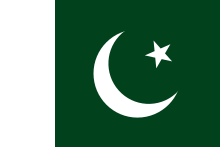This article has multiple issues. Please help improve it or discuss these issues on the talk page. (Learn how and when to remove these messages)
|

Pakistan Vision 2025 is a set of goals for social, economic, security, and governance developments outlined by the government of the Islamic Republic of Pakistan to be achieved by 2025. The overall goal is for Pakistan to become an upper-middle income country by 2025 and to eventually become one of the top ten economies in the world by 2047 (its centennial).
25 goals
The government of Pakistan outlined 25 specific goals they want to achieve by 2025, grouped into seven categories.
Human and Social Capital
Increase primary school enrollment and completion rate to 100% and literacy rate to 90%
The literacy rate was 72% in 2022.
Increase higher education rate to 99% and increase number of PhDs to 19,000
Equalize gender parity in primary and secondary education; increase female workforce participation to 85%
Pakistan's GPI was 0.88 in 2019.
Increase percentage of population with improved sanitation to 90%
Reduce infant mortality to 4% and maternal mortality to 14%
Infant mortality was 5.3% in 2021; maternal mortality was 0.15% in 2020.
Reduce prevalence of Hepatitis, diarrhea, Diabetes, and Heart Disease by 50%
Become world champion in two sports and win 25 medals in the Asian Games
Pakistan had 207 total medals after the 2022 Asian Games.
Sustained Growth
Become one of the largest 25 economies in the world
Pakistan had the 43rd highest GDP in the world in 2024 according to the IMF.
Reduce poverty by 50%
Increase annual FDI to $15 billion
Increase tax to GDP ratio to 18%
Governance
Be in the 50th percentile for political stability, control of corruption, as measured by the World Bank
In 2022, Pakistan was in the 7th percentile for political stability, and 23rd for control of corruption.
Energy, Water, Food
Increase power generation to 42,000 MW; increase electricity access to 90% of population
Reduce cost per energy unit by 25%; increase percentage of indigenous sources of power generation to 50%; increase usage of efficient products to 80%
Increase water storage capacity to 90 days; improve efficiency in agriculture by 20%; ensure access to clean water for all Pakistanis
Reduce food insecure population to 30%
In 2018, 37% of Pakistanis faced food insecurity.
Private Sector
Rank in top 50 for ease of doing business according to the World Bank
In 2019, Pakistan ranked 108th out of 190.
Increase diaspora investments to $40 billion
Create 5 global Pakistani brands
Knowledge
Rank in top 75 in WEF's Global Competitiveness Report
In 2019, Pakistan was 110th.
Triple labor and capital productivity
Improve score on World Bank's Knowledge Economy Index to 4.0; increase internet access to 50%
Increase number of tourists to 2 million
Pakistan had 1.91 million international tourists in 2022.
Transportation
Increase road density to 64 km/100 km; share of rail transport to 20%
Increase annual exports to $150 billion
References
- "World Bank Open Data". World Bank Open Data. Retrieved 2023-11-25.
- "World Bank Open Data". World Bank Open Data. Retrieved 2023-11-25.
- "World Bank Open Data". World Bank Open Data. Retrieved 2023-11-25.
- "World Bank Open Data". World Bank Open Data. Retrieved 2023-11-25.
- "Report for Selected Countries and Subjects". IMF. Retrieved 2023-11-25.
- "Interactive Data Access | Worldwide Governance Indicators". World Bank. Retrieved 2023-11-25.
- "Pakistan | World Food Programme". www.wfp.org. 2023-03-31. Retrieved 2023-11-25.
- "World Bank Open Data". World Bank Open Data. Retrieved 2023-11-25.
- Schwab, Klaus. "The Global Competitiveness Report 2019" (PDF). www3.weforum.org.
- https://tourism.gov.pk/advertisements/Pakistan%20Tourism%20Barometer%20-%20Edition%202022.pdf.
{{cite web}}: Missing or empty|title=(help)
https://www.pc.gov.pk/uploads/vision2025/Vision-2025-Executive-Summary.pdf
https://www.pc.gov.pk/uploads/vision2025/Pakistan-Vision-2025.pdf
Category: